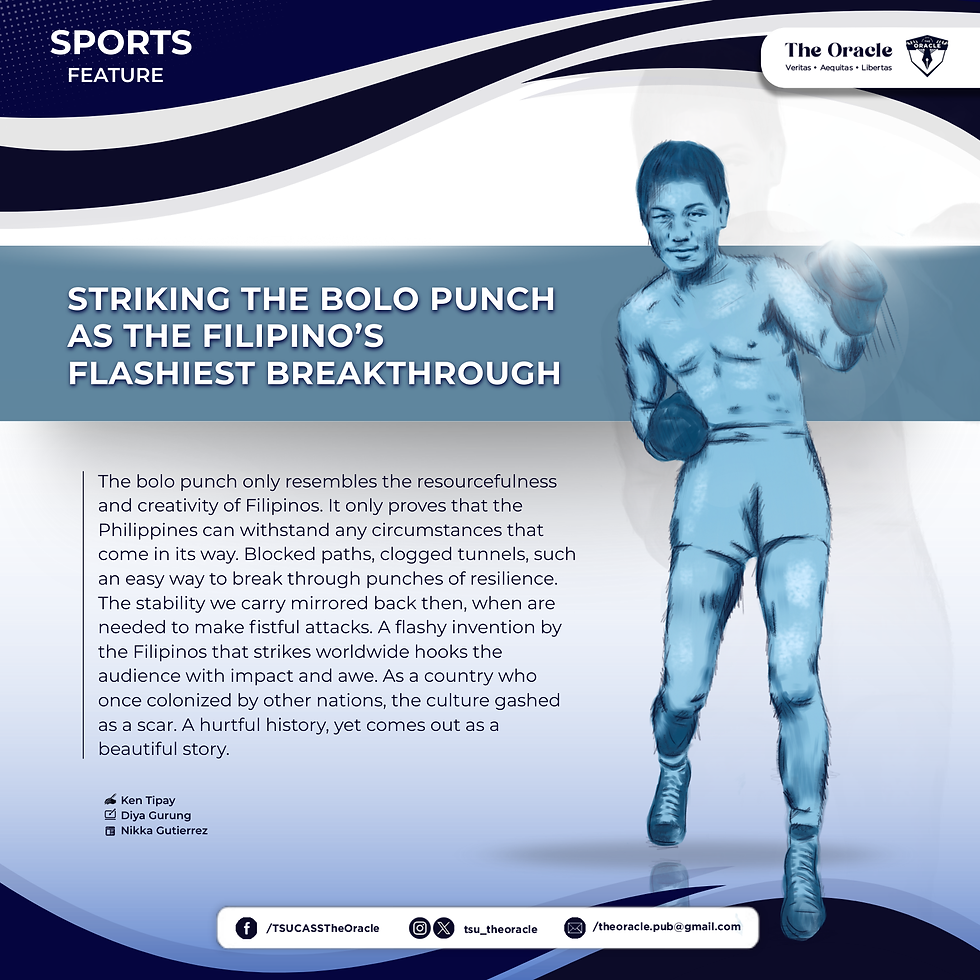Striking the bolo punch as the Filipino’s flashiest breakthrough
- theoraclejourn
- Sep 13
- 3 min read

Report by Ken Tipay | Graphics by Diya Nicole Gurung | Layout by Nikka Gutierrez
As we, Filipinos face multiple disasters, the firmness left by our ancestors sought to keep us standing. We are attained to remain fighting even with no weapons, we use our knuckles. Battling with unyielding fists, set forward for a feast.
In a battle between pride, both are edging on to their grips. Exchanging attacks and slams are a way to reveal the strongest. Using fists to strike tells who has got the might.
A bold invention
From a sport called “boxing,” numerous players have come up with various types of attacks, jab, lead hook, uppercut, cross, and many more. But there is a flashy punch attack that runs in Filipino blood—the bolo punch. It was invented and popularized by a Filipino boxer Ceferino Garcia around 1924. He is also considered as the master and father of the bolo punch. This attack was originally used in martial arts and does not fall under the field of traditional boxing punches.
Froom the roots of farmlands
The word bolo originated from Filipino single-edged knife which is similar to the machete, it is mainly used for clearing vegetation and farmlands. But it is also utilized as one of the crucial weapons in Filipino martial arts.
They call it the bolo punch as the movement resembles the swinging a bolo machete when performing to cut down crops like sugar cane and unhusked rice when working in farmlands or fields.
Striking the bolo punch
In performing this attack, prioritizing your stance and guard is the pillar, being with your normal boxing stance either orthodox or southpaw. Swing your rear arm (usually the right for orthodox fighters) in a circular or “stirring” motion — like mixing something. This distracts the opponent, making them anticipate a wide hook or body shot. The free hand (usually the lead hand) stays in position to jab or defend if needed. And then the strike, from the circular motion, swiftly whip the same arm into a punch. It can land as an uppercut, hook, or hybrid punch, depending on the angle. The key is that the strike comes unexpectedly or “flashy,” after the “bolo” motion. And lastly, snap and recover. Deliver the punch sharply with speed and snap, not as a wild swing, immediately bring the hand back to guard to avoid counters.
The bolo punch was labeled with tons of names such as “confidence punch” as this move tends to entertain the crowd, it also works best when the opponent is distracted, tired, or even expecting a different punch.
Names behind the success of bolo punch
While Cerefrino Garcia was credited as the bolo punch inventor, a professional Cuban boxer named Kid Gavilan was considered as popularizing it worldwide. There are also some boxers that threw the bolo punch as a great technique inside the ring during big fights such as Manny Pacquiao. Filipino boxer Gabriel “Flash” Elorde was also seen occasionally performs the bolo punch during his fights. Additionally, Amercian boxer Sugar Ray Leonard was famously attacks with the bolo punch as a taunt and to surprise the opponents.
A Filipino's gift to the world
In some local boxing gyms, the bolo punch is often taught to young boxers as an honor to cultural pride, reflecting that a Filipino invented the boxing’s flashiest punches.
The bolo punch only resembles the resourcefulness and creativity of Filipinos. It only proves that the Philippines can withstand any circumstances that come in its way. Blocked paths, clogged tunnels, such an easy way to break through punches of resilience. The stability we carry mirrored back then, when are needed to make fistful attacks. A flashy invention by the Filipinos that strikes worldwide hooks the audience with impact and awe. As a country who once colonized by other nations, the culture gashed as a scar. A hurtful history yet comes out as a beautiful story.



Comments